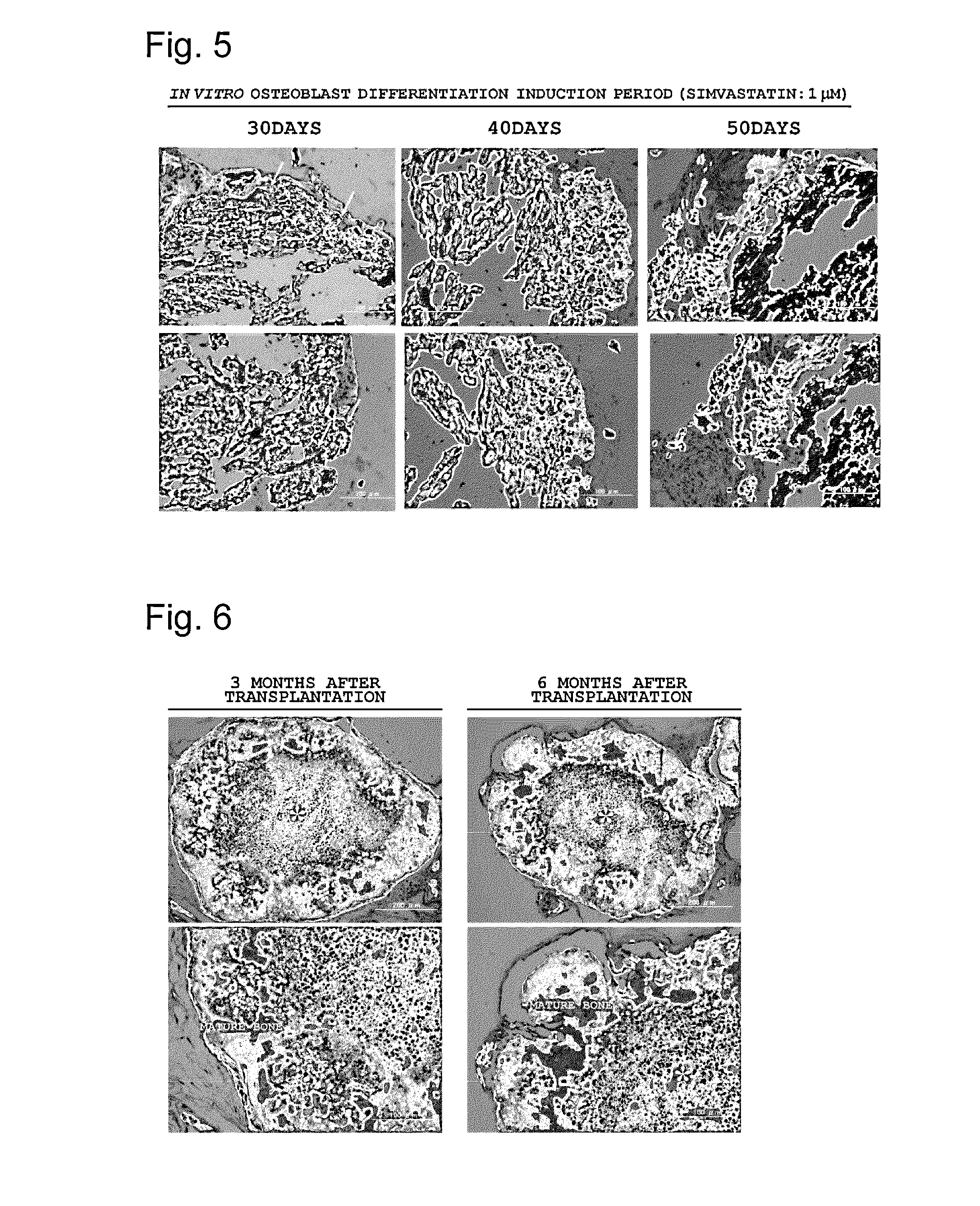Method for inducing differentiation enabling tumorigenesis of ips cells to be suppressed
a technology of ips cells and differentiation, which is applied in the field of inducing differentiation enabling tumorigenesis of ips cells to be suppressed, can solve the problems of difficult securing adequate numbers of cells, risk of contamination, and difficult cases of patients for dental implants and prosthodontic treatment, and achieves the effects of improving the efficiency of ips cell establishment, high efficiency, and being convenient and extremely practical for clinical us
Active Publication Date: 2014-12-04
TOHOKU UNIV
View PDF0 Cites 2 Cited by
- Summary
- Abstract
- Description
- Claims
- Application Information
AI Technical Summary
Benefits of technology
[0099]“Derivatives” here include those in which the position of a substituent has been changed, those in which one molecule has been replaced by another molecule, those in which a specific substituent has been added, and those in which a specific substituent has been removed or the like while maintaining the basic framework represented by the general formula. There are no particular limits on what derivatives can be used in the invention as long as they act on iPS cells, but lactones and esters are desirable for example.
[0100]One of these statins may be used alone in the present invention, or two or more may be used in combination.
[0102]Differentiation inducers that induce differentiation of iPS cells into differentiated cells are well known, and a differentiation inducer may be selected appropriately according to the target differentiated cells in the present invention.
[0103]For example, inducers of differentiation into osteoblasts include ascorbic acid, β-glycerophosphoric acid, dexamethasone, BMP-2, hydrocortisone hemisuccinate, retinoic acid and the like; inducers of differentiation into nerve cells include nerve growth factor (NGF), brain derived nerve growth factor (BDNF), retinoic acid and the like; inducers of differentiation into liver cells include hexachlorophene, quercetin, ionomycin and the like; inducers of differentiation into fat cells include allyl isothiocyanate, cinnamaldehyde, icilin and the like; inducers of differentiation into myocardial cells include BMP-4, BMP-5, FGF-10, cyclosporine A, ascorbic acid and the like; inducers of d
Problems solved by technology
Cells that are known to be pluripotent include ES cells as well as iPS cells, but with ES cells there are problems of bioethics because the cells are obtained from pre-implantation stage embryos, hence there have been problems in using such cells in regenerative medicine.
In the dental field for example, dental implant treatment and prosthodontic treatment are often difficult in cases of patients who have lost teeth, due to bone loss in the jaw.
Because iPS cells are pluripotent, however, there have been serious problems with t
Method used
the structure of the environmentally friendly knitted fabric provided by the present invention; figure 2 Flow chart of the yarn wrapping machine for environmentally friendly knitted fabrics and storage devices; image 3 Is the parameter map of the yarn covering machine
View moreImage
Smart Image Click on the blue labels to locate them in the text.
Smart ImageViewing Examples
Examples
Experimental program
Comparison scheme
Effect test
 Login to View More
Login to View More PUM
| Property | Measurement | Unit |
|---|---|---|
| Molar density | aaaaa | aaaaa |
| Concentration | aaaaa | aaaaa |
Login to View More
Abstract
The object of the invention is to provide a technique of suppressing tumorigenesis in IPS cells and inducing differentiation into target differentiated cells. In use of a statin and a differentiation inducer, iPS cells are differentiated into target differentiated cells, whereby iPS cells can be differentiated into differentiated cells in which tumorigenesis is suppressed.
Description
TECHNICAL FIELD[0001]The present invention relates to a technique for differentiating iPS cells into target differentiated cells while suppressing tumorigenesis in the iPS cells.BACKGROUND ART[0002]Human iPS cells have been established (see for example Non-Patent Document 1 and Patent Document 1), and hold promise in the field of regenerative medicine. iPS cells, also called artificial pluripotent stem cells or induced pluripotent stem cells, are cells with acquired pluripotency, and these cells acquire pluripotency by the introduction of genes coding for various kinds of transcription factors, such as Oct family (Oct3 / 4), Sox family (Sox2, Sox1, Sox3, Sox15, Sox 17, etc.), Klf family (Klf4, Klf2, etc.), Myc family (c-Myc, N-Myc, L-Myc, etc.), Nanog and LIN28 transcription factors, that confer pluripotency on somatic cells (such as fibroblasts for example).[0003]Cells that are known to be pluripotent include ES cells as well as iPS cells, but with ES cells there are problems of bioe...
Claims
the structure of the environmentally friendly knitted fabric provided by the present invention; figure 2 Flow chart of the yarn wrapping machine for environmentally friendly knitted fabrics and storage devices; image 3 Is the parameter map of the yarn covering machine
Login to View More Application Information
Patent Timeline
 Login to View More
Login to View More IPC IPC(8): A61K35/32C07D209/26C07D309/30
CPCA61K35/32C07D209/26C07D309/30C12N5/0696C12N2501/71C12N2501/999A61K31/40A61K31/405A61K31/44A61K31/505
Inventor EGUSA, HIROSHI
Owner TOHOKU UNIV
Features
- R&D
- Intellectual Property
- Life Sciences
- Materials
- Tech Scout
Why Patsnap Eureka
- Unparalleled Data Quality
- Higher Quality Content
- 60% Fewer Hallucinations
Social media
Patsnap Eureka Blog
Learn More Browse by: Latest US Patents, China's latest patents, Technical Efficacy Thesaurus, Application Domain, Technology Topic, Popular Technical Reports.
© 2025 PatSnap. All rights reserved.Legal|Privacy policy|Modern Slavery Act Transparency Statement|Sitemap|About US| Contact US: help@patsnap.com



